Virgin Coconut Oil Production by Centrifugation Method
Y.C.Wong1* and H. Hartina1
1Faculty of Agro Based Industry, Universiti Malaysia Kelantan, Jeli Campus, Locked Bag 100, 17600 Jeli, Kelantan, Malaysia.
DOI : http://dx.doi.org/10.13005/ojc/300129
Article Received on :
Article Accepted on :
Article Published : 27 Jan 2014
The virgin coconut oil (VCO) production by centrifugation method was studied. The production of VCO was studied by using various centrifugation speed, temperature and time intervals. The results showed that the yield of VCO was 13.53% at 12000rpm, at 120 minutes. The highest yield of VCO was 13.80% at centrifugation temperature of 40oC. The concentration of lauric acid present in the samples with variables of centrifugation temperatures, speed, and time intervals were 0.4543µg, 6.2367µg, and 6.4894µg respectively.
KEYWORDS:centrifugation; virgin coconut oil; yield of VCO
Download this article as:| Copy the following to cite this article: Wong Y. C, Hartina H. Virgin Coconut Oil Production by Centrifugation Method. Orient J Chem 2014;30(1) |
| Copy the following to cite this URL: Wong Y. C, Hartina H. Virgin Coconut Oil Production by Centrifugation Method. Orient J Chem 2014;30(1). Available from: http://www.orientjchem.org/?p=1987 |
Introduction
Nowadays, virgin coconut oil (VCO) and olive oil are the most valuable oil. The reason is because they have the potential effects on human health. So, these two types of oils are categorized as functional food oils [1].
The physical methods for producing VCO includes the process of pressing, washing with water, settling, filtering and centrifugation. However, the natural way to produce VCO is through fermentation process in which it occurs through naturally-occurring microorganisms. VCO can be produced through four common methods which are centrifugation, fermentation with heat, fermentation without heat and expelling [2].
The objectives of this study are to study the production of virgin coconut oil via centrifugation and the factors that affect its production, as well as to determine the quantity of active compounds present in virgin coconut oil using high performance liquid chromatography.
Materials and Method
Preparation of Coconut Milk
In this experiment, only one type of coconut milk was experimented. Fresh and mature coconut was bought from a local area in Jeli Town, Kelantan and underwent centrifugation process right after the purchase. The samples were filtered with filter paper prior to centrifugation. There were no chemicals involved in the process of producing coconut milk bought from the local shop. Rotary wedge cutter was used to disintegrate the white coconut kernel. The size of the filter paper was Grade 104 of Millipore filter paper with 11 µm particle retention. Coconut milk was filtered through the filter paper before it was ready for the centrifugation process.
Effect of Centrifugation Speed on Production of VCO
The experiment was started by using filtered and centrifuged coconut milk. 50ml of coconut milk was centrifuged according to the parameters set. After centrifuged, the upper layer part of the oil was taken out to measure the yield of VCO by percentage.
The Yield of VCO was determined in percentage according to the following Equation 1:
A = B / C × 100% —————————————————————————–Equation 1
where A is yield percentage of virgin coconut oil, B is the volume of oil extracted (mL), and C is volume of coconut milk (mL). The test was repeated by changing the speed of the centrifuge which were 2000, 4000, 6000, 8000, 10000, and 12000 rpm.
Effect of Centrifugation Times on Production of VCO
In this experiment, 50 mL fresh coconut milk was used. PP tube containing fresh coconut milk was gently placed into the centrifuge. The fresh coconut milk was centrifuged at different time intervals starting at 15 minutes. This was repeated at 30 min, 60 min, 90 min, and 120 min. After centrifugation, the upper layer part of the oil was taken out to measure the yield of VCO by percentage. The yield of VCO was determined in percentage according to Equation 1.
Effect of Various Temperatures on VCO Production
PP tube containing 50mL of fresh coconut milk was gently placed into the centrifuge. The fresh coconut milk was centrifuged at different temperature interval beginning at 20oC. This was repeated at 25oC, 30oC, 35oC, 40oC. After centrifuged, the upper layer part of the oil was taken out to measure the yield of VCO by percentage. The Yield of VCO was determined in percentage according to Equation 1.
Moisture Content
The determination of moisture content was based on the AOAC method (AOAC, 1997) with slight alteration. Samples were heated at 105°C in an oven and weighed crucible for at least 7 hours and cooled to a room temperature and re-weighed with the samples inside until constant readings were obtained. The analysis was done in triplication. The petri dish was weighted using analytical balance to determine the moisture lost. The moisture content was determined in percentage according to the following Equation 2.
M = m2 – m3/ m2- m1 × 100 = Loss in weight x 100% ——————————— Equation 2
where M is moisture content, ml is weight of the empty container with its cover, m2 is weight of the container with its cover and sample before drying and m3 is weight of the container with its cover and sample after drying.
High Performance Liquid Chromatography (HPLC) Analysis
0.01grams of coconut oil was added to 4mL of acetonitrile as the sample preparation step before injecting it into the HPLC. 5µL of sample was injected into the HPLC system to analyze the fatty acid composition. The fatty acid composition in virgin coconut oil was analyzed using HPLC method. The HPLC analysis parameters were determined using the following conditions: column, C18 RP (53 x 7mm); injector temperature was 35oC, 5 µL of the sample was injected into the HPLC system. The mobile phase was 100:0, acetonitrile:methanol and the flow rate was 3.5mL/min; and detection was set at a wavelength of 228 nm.
Results and Discussion
Effect of Centrifugation Speed on Production of VCO
At centrifugation time of 15 minutes at 40°C according from Table 1 and Figure 1, it was found that the yield of VCO increased gradually when the centrifugation speed increased from 2000 rpm to 12000 rpm. The centrifugation method managed to produce the virgin coconut oil. The oil was able to be separated from the fresh coconut milk even though the centrifugation time was only 15 minutes. Besides that, the results showed that the maximum yield of virgin coconut oil produced was 9.1233% with a standard deviation of ±0.2804.
Table 1: The Results total of VCO yield (%) under different centrifugation speed (rpm) at centrifugation time of 15 minutes at 400C.
|
Centrifugation Speed (rpm) |
Yield of VCO (%) |
Mean ± SD |
||
|
2000 |
1.40 |
2.60 |
2.70 |
2.2333 ± 0.7234 |
|
4000 |
2.20 |
3.00 |
3.30 |
2.8333 ± 0.5686 |
|
6000 |
4.80 |
5.00 |
5.20 |
5.0000 ± 0.2000 |
|
8000 |
6.10 |
7.10 |
7.30 |
6.8333 ± 0.6429 |
|
10000 |
8.40 |
8.70 |
9.00 |
8.7000 ± 0.3000 |
|
12000 |
8.80 |
9.30 |
9.70 |
9.1233 ± 0.2804 |
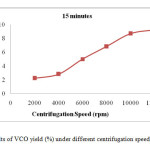 |
Figure 1: Results of VCO yield (%) under different centrifugation speed (rpm) at 15 min. Click here to View figure |
Based from Table 2 and Figure 2, the highest yield was obtained at 12000 rpm at 30 minutes. The higher the centrifugation speed, the higher the yield of VCO. At 30 minutes of centrifugation with 12000 rpm, the VCO yield increased significantly when the speed of centrifugation was increased. As a result, the yield of VCO was at maximum value when centrifugation speed of 12000 rpm was used. The mean value of VCO at centrifugation speed of 12000rpm was 10.1000 with a standard deviation of ±0.4359.
Table 2: The Results total of VCO yield (%) under different centrifugation speed (rpm) at centrifugation time of 30 minutes at 400C.
|
Centrifugation Speed (rpm) |
Yield of VCO (%) |
Mean ± SD |
||
|
2000 |
1.50 |
2.80 |
3.00 |
2.4333 ± 0.8145 |
|
4000 |
2.80 |
3.50 |
3.50 |
3.2667 ± 0.4041 |
|
6000 |
5.10 |
5.30 |
5.40 |
5.2667 ± 0.1528 |
|
8000 |
6.30 |
7.60 |
7.60 |
7.1667 ± 0.7506 |
|
10000 |
9.30 |
9.70 |
10.30 |
9.7667 ± 0.5033 |
|
12000 |
9.60 |
10.40 |
10.30 |
10.1000 ± 0.4359 |
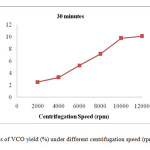 |
Figure 2: Results of VCO yield (%) under different centrifugation speed (rpm) at 30 minutes. Click here to View figure |
The graph of 60 minutes of centrifugation time in Figure 3 indicated that the VCO yield increased steadily as the centrifugation speed increased. The VCO yield escalated sharply when the centrifugation speed increased from 4000 rpm to 10000 rpm. The VCO yield increased from 2.7667% to 10.7000%. At this stage, VCO was produced in high amount due to sufficient force on breaking the emulsion on the surface of the coconut milk to produce coconut oil. The curve for the yield of VCO against centrifugation speed at centrifugation time of 15 and 30 minutes were almost similar as both curve showed the highest peak at 12000 rpm. Further increased in the centrifugation speed increased the yield of VCO. This was explained when the emulsion was formed by homogenizing pure oil and pure water together, these two phases usually rapidly separated into a system that consisted of a layer of oil (lower density) on top of a layer of water (higher density). So, the tent of merging droplets tent to merge with their neighbor when they collided with each other, which eventually led to complete phase separation.
Table 3: The Results total of VCO yield (%) under different centrifugation speed (rpm) at centrifugation time of 60 minutes at 400C.
|
Centrifugation Speed (rpm) |
Yield of VCO (%) |
Mean ± SD |
||
|
2000 |
1.70 |
3.00 |
3.60 |
2.7667 ± 0.9713 |
|
4000 |
3.50 |
3.60 |
3.90 |
3.6667 ± 0.2082 |
|
6000 |
5.20 |
5.70 |
5.90 |
5.6000 ± 0.3606 |
|
8000 |
6.80 |
8.20 |
8.20 |
7.7333 ± 0.8083 |
|
10000 |
9.90 |
10.70 |
11.00 |
10.5333 ± 0.5686 |
|
12000 |
10.20 |
10.90 |
11.00 |
10.7000 ± 0.4359 |
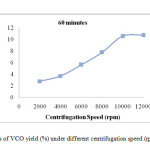 |
Figure 3: Results of VCO yield (%) under different centrifugation speed (rpm) at 60 minutes. Click here to View figure |
At 90 minutes of centrifugation time as shown in Figure 4, it indicated that there was an increase in the yield of VCO when the centrifugation speed increased from 3.0667 % to 11.7000 %. After that, the yield of VCO gave the highest yield at 12000 rpm at 11.7000% with a standard deviation ±0.3606. As the amount of centrifugation speed increased, the yield of VCO produced from fresh coconut milk also increased.
Table 4: The Results total of VCO yield (%) under different centrifugation speed (rpm) at centrifugation time of 90 minutes at 400C.
|
Centrifugation Speed (rpm) |
Yield of VCO (%) |
Mean ± SD |
||
|
2000 |
2.20 |
3.10 |
3.90 |
3.0667 ± 0.8505 |
|
4000 |
4.00 |
4.10 |
4.40 |
4.1667 ± 0.2082 |
|
6000 |
5.40 |
5.90 |
6.50 |
5.9333 ± 0.5508 |
|
8000 |
7.00 |
8.50 |
9.10 |
8.2000 ± 1.0817 |
|
10000 |
10.40 |
11.10 |
11.70 |
11.0667 ± 0.6506 |
|
12000 |
11.40 |
11.60 |
12.10 |
11.7000 ± 0.3606 |
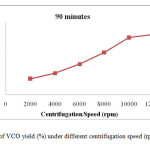 |
Figure 4: Results of VCO yield (%) under different centrifugation speed (rpm) at 90 minutes. Click here to View figure |
Figure 5 showed a graph with the result of VCO yield in which the centrifugation time used was 120 minutes, the yield of VCO increased gradually when the centrifugation speed was increased from 2000 rpm to 12000 rpm. The difference of VCO yield was 10.03% from the highest yield which was 13.5300% whereas the lowest yield was 3.5000%. 120 minutes of centrifugation time helped the coconut milk to become more readily able to yield VCO. The VCO was fully produced when the highest centrifugation speed of 12000 rpm was used at centrifugation time of 120 minutes. The trend in increasing centrifugation speed resulted in the increase of the rate of sedimentation and the emulsion separation of two immiscible liquids according to Abdvrahman H. Nour et al., 2009 [3].
Table 5: The Results total of VCO yield (%) under different centrifugation speed (rpm) at centrifugation time of 120 minutes at 400C.
|
Centrifugation Speed (rpm) |
Yield of VCO (%) |
Mean ± SD |
||
|
2000 |
1.50 |
2.80 |
3.00 |
3.5000 ± 0.8544 |
|
4000 |
2.80 |
3.50 |
3.50 |
4.6000 ± 0.2646 |
|
6000 |
5.10 |
5.30 |
5.40 |
6.7300 ± 0.3055 |
|
8000 |
6.30 |
7.60 |
7.60 |
8.9000 ± 0.6557 |
|
10000 |
9.30 |
9.70 |
10.30 |
11.9700 ± 0.4726 |
|
12000 |
9.60 |
10.40 |
10.30 |
13.5300 ± 0.3512 |
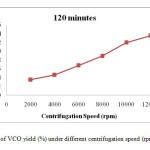 |
Figure 5: Results of VCO yield (%) under different centrifugation speed (rpm) at 120 minutes. Click here to View figure |
Effect of Centrifugation Times on Production of VCO
Time was one of the important factors that determined the yield of VCO. There were five different times of centrifugation used which were 15, 30, 60, 90, and 120 minutes at 40°C. Figure 6 showed the plot of VCO yield against the centrifugation time. The highest yield of VCO at 120 minutes was due to the rapid separation by centrifugation speed. As it went from 15 minutes to 120 minutes, the VCO yield started to increase. At the point of 15 minutes, the yield of VCO was at minimum, 2.23% at 2000 rpm. The reason was the longer the separation process, the more oil droplets were allowed to be separated from the emulsion.
Table 6: Overall results of VCO produced (%) by using different centrifugation times and different centrifugation speed (rpm) at 400C.
|
Centrifugation Time (min) |
Centrifugation Speed (rpm) |
|||||
|
2000 |
4000 |
6000 |
8000 |
10000 |
12000 |
|
|
15 |
2.23 |
2.83 |
5.00 |
6.83 |
8.70 |
9.27 |
|
30 |
2.53 |
3.27 |
5.27 |
7.17 |
9.77 |
9.87 |
|
60 |
2.77 |
3.67 |
5.60 |
7.73 |
10.53 |
10.57 |
|
90 |
3.07 |
4.17 |
5.93 |
8.20 |
11.07 |
11.70 |
|
120 |
3.50 |
4.60 |
6.73 |
8.90 |
11.97 |
13.53 |
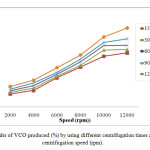 |
Figure 6: Results of VCO produced (%) by using different centrifugation times and different centrifugation speed (rpm). Click here to View figure |
Effect of Various Temperatures on Production of VCO
Based from Figure 7, the result showed the effect of temperatures on the yield of VCO. The parameters fixed were between 20°C to 40oC. The result showed the maximum of VCO yield was at 40°C at a value of 13.80%. The main reason the VCO yield increased when the centrifugation temperature increased was due to the force which was enough to break the emulsion formed by the coconut milk. Moreover, according to Peamprasart and Chiewchan, after increasing the centrifugation temperature up to 50oC, the denaturation process will affect the proteins. In other words, stability of proteins depends on temperature to be treated. This is because the centrifuge will generate heats by centrifugal rotation. The parameters used in the research only reached 40oC, so the denaturation process did not occur in the research. Whereby increasing the centrifugation temperature will increase the yield of VCO. They also reported that some proteins denature during heating at 80oC resulting in the aggregation of oil droplets.
Table 7: Results for the VCO yield (%) with effect of centrifugation speed at different temperatures.
|
Centrifugation Temperature (0C) |
Centrifugation Speed (rpm) |
|||||
|
2000 |
4000 |
6000 |
8000 |
10000 |
12000 |
|
|
20 |
Yield of VCO (%) |
|||||
|
0.00 |
0.00 |
0.00 |
0.00 |
1.30 |
3.10 |
|
|
25 |
0.00 |
0.00 |
0.00 |
0.30 |
4.70 |
6.30 |
|
30 |
2.60 |
4.40 |
6.30 |
8.10 |
11.50 |
13.10 |
|
35 |
3.20 |
4.30 |
6.60 |
8.90 |
11.60 |
13.40 |
|
40 |
4.20 |
4.70 |
6.80 |
9.50 |
12.30 |
13.80 |
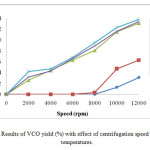 |
Figure 7: Results of VCO yield (%) with effect of centrifugation speed at different temperatures. Click here to View figure |
The aggregation of oil droplets occurred due to the destabilization of coconut milk emulsion by denaturation of heat labile proteins during heating. Coconuts milk consists of protein content that plays a vital role on the emulsion stability while heating the coconut milk at higher temperature will cause denaturation of protein. Moreover, the aggregation of oil droplets occured due to thermal denaturation of proteins stabilizing coconut milk emulsion will affect the surface charge of oil droplets. Droplets with lower surface charge interact with each other and coalesce into larger ones. Finally, the close contact among large droplets (higher interaction time) and applied force during centrifugation led to destabilization of emulsion, resulting in the phase separation and formation of oil and aqueous layers [4]. Hence, the complete coconut milk emulsion destabilization occurred when the coconut milk was heated up to 80oC thus will denature most of the proteins.
Moisture Contents
Moisture content (MC) was also an important parameter which played important role in the determination of the quality control of the VCO samples that had been produced. The results showed that the MC of VCO ranged from 0.88% to 1.03% as shown in Table 8, 9, and 10. The results for the moisture contents (%) with effect of centrifugation speed (rpm) was at 0.88% whereas with effect of centrifugation time (min) and centrifugation temperature (oC) gave value of about 1.03% and 0.93% respectively. However, these results did not fall in the range of APCC standards of moisture % wt. max range between 0.1 to 0.5%.
Table 8: Results for the moisture contents (%) with effect of centrifugation speed (rpm).
|
Centrifugation speed (rpm) |
Weight of the empty container (g) |
Weight of container and sample before drying (g) |
Weight of container and sample after drying (g) |
Loss in Weight (M1-M2) (g) |
% of moisture content |
|
A |
29.666 |
32.264 |
32.239 |
0.025 |
0.96 |
|
B |
25.593 |
28.232 |
28.212 |
0.020 |
0.76 |
|
C |
28.687 |
31.227 |
31.204 |
0.023 |
0.91 |
|
Average |
27.982 |
30.574 |
30.552 |
0.023 |
0.88 |
Table 9: Results of the moisture contents (%) with effect of centrifugation time (min).
|
Centrifugation time (min) |
Weight of the empty container (g) |
Weight of container and sample before drying (g) |
Weight of container and sample after drying (g) |
Loss in Weight (M1-M2) (g) |
% of moisture content |
|
A |
25.762 |
28.341 |
28.315 |
0.026 |
1.01 |
|
B |
29.525 |
32.113 |
32.085 |
0.028 |
1.08 |
|
C |
29.671 |
32.144 |
32.119 |
0.025 |
1.01 |
|
Average |
28.319 |
30.866 |
30.840 |
0.026 |
1.03 |
Table 10: Results of the moisture contents (%) with effect of centrifugation temperatures (0C).
|
Centrifugation Temperature (0C) |
Weight Of The Empty Container (G) |
Weight Of Container And Sample Before Drying (G) |
Weight Of Container And Sample After Drying (G) |
Loss In Weight (M1-M2) (G) |
% Of Moisture Content |
|
A |
29.546 |
32.271 |
32.248 |
0.023 |
0.84 |
|
B |
29.663 |
32.288 |
32.262 |
0.026 |
0.99 |
|
C |
28.637 |
31.190 |
31.165 |
0.025 |
0.98 |
|
Average |
29.715 |
31.916 |
31.892 |
0.025 |
0.94 |
Furthermore, the main reason of the results being out of range from APCC standards was that the sample was not preserved well as it was exposed to room temperature for a long period of time. The moisture content of the oil was one of the parameters which affects the shelf life [5]. The higher the moisture content, it will adversely influence the oxidation process and thus promoting rancidity. Free fatty acids were higher in coconut oil having higher moisture content. So, the reason to keep the moisture content as low as possible was in order to increase the shelf life of VCO while preventing the oxidation and rancidity process to occur that can affect the quality of VCO.
The oxidation process occurred due to the presence of light and the samples were exposed to light directly. The rancidity occurred due to the active oxygen, heat, metal, or light. Rancidity is the condition reached by certain food where oxidation reaction occurs by lipid material (fat) due to production of hydroxy acids, keto acids, aldehydes, short-chain fatty acids, and other compounds which are responsible for the characteristics of off-flavors and off-odors in stale food.
High Performance Liquid Chromatography (HPLC) Analysis
Table 11 showed that the retention times of lauric acid standard and the samples were significantly same and they did not vary too much. The lauric acid standard was done in triplicate and the retention times were 1.228, 1.240, and 1.239 respectively whereas the samples with parameters of centrifugation speed, temperature and time produced 1.220, 1.408, and 6.251 retention times respectively. From the triplicate of lauric acid standard, the highest peak area was at replicate 1 which was 115980. Since it gave the highest peak, its retention time was also the shortest compared with the other two replicates. As for the sample, the highest peak area contributed to time was 639585. It also showed the highest retention time compared to others.
Table 11: Retention time and peak areas of lauric acid standard and samples.
|
Internal Standard |
Samples |
|||||
|
Lauric Acid (1) |
Lauric Acid (2) |
Lauric Acid (3) |
Speed |
Temperature |
Time |
|
|
Retention Time (min) |
1.228 |
1.240 |
1.239 |
1.220 |
1.408 |
6.251 |
|
Peak Area |
115980 |
67433 |
67902 |
57867 |
2468 |
639585 |
The slight variability of the retention time between chromatographic systems can be due to various factors regarding the different specification of each HPLC system, column temperature and length of tubing between the injector and column. In particular, the column aging and the prolonged usage of the chromatography column could also cause the drifting in the retention time. Ultimately, in order to overcome this problem, some modifications are required for the chromatographic conditions. For example, the column temperature during this experiment was ambient and not controlled and in order to overcome the temperature effect on the retention time, a column oven is recommended.
Table 12 showed the calculated concentration of lauric acid present in the samples. The concentration of lauric acid present in the samples of centrifugation speed was 6.2367µg. However, the calculated concentration lauric acid present in centrifugation temperature is the lowest which was 0.4543µg meanwhile the samples with centrifugation time gave a value of 6.4894 µg of lauric acid. This value is the highest value obtained in these three types of samples. The main reason lauric acid standard present least in the centrifugation temperature sample was due to the overlook of the preservation of the sample. The sample was supposed to be preserve in the freezer at -20oC but due to maintenance problem, the chemical composition in the sample was altered unintentionally. On the other hand, this result had showed that the major component of tropical oils such as coconut oil consists of lauric acid.
Table 12: Concentrations of lauric acid.
|
Sample |
Lauric acid standard |
Peak Area |
Calculated Concentration (µg) |
|
|
Sample |
Lauric acid standard |
|||
|
Speed |
1 |
10050 |
115980 |
6.2367 |
|
Time |
2 |
639585 |
67433 |
6.4894 |
|
Temperature |
3 |
2468 |
67902 |
0.4543 |
Conclusion
From the results of the experiment, centrifugation was indeed a potential method of producing high yield VCO which can be applied at industrial level. The 12000 rpm centrifugation speed showed the best separation compared to other centrifugation speeds. The high performance of centrifugation speed makes it ideal in producing high yield of VCO and it is one of the alternative ways to produce VCO instead of other traditional methods such as fermentation. There are few factors that can cause the yield of VCO to become unstable such as the temperatures of the centrifuge machine. When the temperature was set from 20oC to 25oC, the samples cannot be placed inside the centrifuge machine straight away because the coconut milk became solidified, thus can affect the parameters that need to be determined. In order to avoid that, the centrifuge needs to be exposed to room temperature for about 15 minutes before continuing the experiment. In addition, extended exposure of the coconut milk to the environment can cause oxidation process to occur which led to rancidity of the samples. All these factors need to be considered in order to ensure high accountability and reliability of the research. The concentration of lauric acid presents in the samples with parameters of centrifugation temperature, speed, and time were 0.4543µg, 6.2367µg, and 6.4894µg respectively.
Conflict of Interests
The Authors declare that there is no conflict of interests regarding the publication of this article.
References
- Marina, A. M., Che Man, Y. B., Nazimah, S. A. H., & Amin, I. (2009a). Chemical properties of virgin coconut oil. Journal of the American Oil Chemists’ Society, 86, 301-307.
- Dia, V. P., Garcia, V. V., Mabesa, R. C., & Tecson-Mendoza, E. M. (2005). Comparative physicochemical characteristics of virgin coconut oil produced by different methods. Philippine Agricultural Sciences, 88, 462-475.
- Az, N. (2009). Demulsification of Virgin Coconut Oil by Centrifugation Method. International Journal of Chemical Technology , 1 (2), 59-64.
- Chiewchan, S. J., & A, N. T. (2004). Effect of Fat Content and Temperature on The Apparent Viscosity of Coconut Milk. Journal of Food Engineering , 64, 193-197.
- Manaf, M. A., Che Man, Y. B., Hamid, N. S. A., Ismail, A., & Abidin, S. Z. (2007). Analysis of adulteration of virgin coconut oil by palm kernel olein using Fourier transform infrared spectroscopy. Journal of Food Lipids, 14, 111-121.

This work is licensed under a Creative Commons Attribution 4.0 International License.









